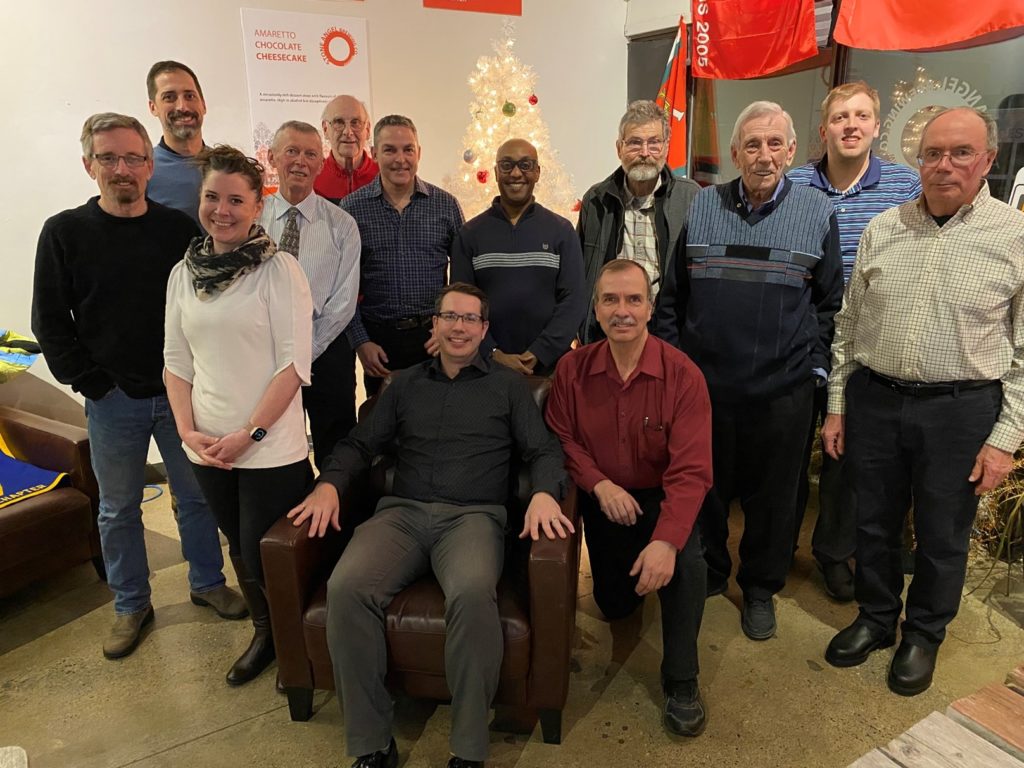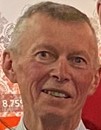
Past-Presidents Night, Dec 21, 2022, Stone Angel Brewery
Front row, left to right: Doug Castor, Kelli Goldstone, Corey Nation(seated), Denton Vandersteen
Back row, left to right: Sergio Almeida, Dieter Bartel, Robert McDowall, George Marchildon, Stirling Walkes, Bert Phillips, Neil Childs, Justin Albo, David Stones

ASHRAE Leadership Interview – November 30, 2022
Dieter Bartel, Chapter President 1989
Background
Dieter was born in Winnipeg and has lived here all his life. He attended high-school at Miles Macdonell Collegiate. He then took a one-year course in architectural drafting at what then called Red River Community College (RRCC).
He is 66 and has been married for 45 years. They have a son and two grand-sons.
What attracted you to engineering and/or the HVAC industry?
An instructor called Bill Sutherland, spoke to our class about mechanical systems near the end of the first term. He convinced me to take mechanical systems in the second term.
What was your first job in the HVAC industry and where did it lead?
Dieter graduated in 1975 and Bill Sutherland had set up 3 interviews from which he was hired by Scouten, Mitchell, Sigurdson (SMS). He moved to EJ Faraci and Associates for 2 years and then went back to SMS, all which gave him excellent experience in HVAC systems. He was 19 years old when he graduated from RRCC.
Dieter started with Centra Gas in 1989, working in a number of positions. In 1999, Centra Gas was purchased by Manitoba Hydro. He continued using his HVAC experience to assist customers having problems with equipment and to use their systems more efficiently. He would travel to the utility office around the province, to help with new buildings being constructed in their respective areas.
He returned to SMS as Senior Mechanical Designer in the mid-1990s for 2 years and then moved back to Centra Gas in 1998.
Construction of the Seven Oaks Hospital started in 1979, while Dieter was at SMS. He was tasked, while at SMS, layout of systems in the 20,000 sq ft mechanical penthouse for the hospital. He also calculated the heating and cooling loads for the building. Ray Scouten introduced him to pneumatic tube systems, used for moving documents and other items within the hospital. Blower and diverting units for this system were also located in the penthouse. After that project, Dieter said he felt he could take on almost any type of project.
The Air Canada hangar was another major project for him.
He retired from Manitoba Hydro as Commercial Energy Specialist in 2017.
What were the challenges that you and your colleagues were facing?
Dieter said nothing major that he could recall. Many of the graduates from his RRCC course found work in architectural and HVAC related industry. It was a busy time with construction of many types of projects – care homes, schools government office, etc.
How and when did you get started in ASHRAE?
Dieter was at EJ Faraci & Associates at the time. He overheard Les Howard, who was there was there promoting sales. Les asked if he had been invited to Ladies Night for ASHRAE in November, 1979. Dieter wasn’t a member of ASHRAE then, but Les provided tickets for him and for his wife to attend. They enjoyed the event and in 1980 he joined ASHRAE.
What was your ASHRAE chapter and/or regional and Society experience?
The Chapter Regional Conference (CRC) was due to be held in 1985 in Winnipeg. Robert McDowall was the Chapter President and Chair for that CRC and he asked for volunteers in 1984. Dieter volunteered. He worked with the reception committee and met many individuals from around the Region. The next year he became Membership Chair for Manitoba. He said from that point, he was hooked.
He attended CRC as Membership Chair and then had other positions in the Chapter. and other CRCs and eventually became Regional Vice-Chair for Membership in the 1990s.
He would share information and his experience with ASHRAE at all levels with others where he worked.
He was an ASHRAE member for 37 years.
What were the major issues facing the industry at that time?
Dieter recalled:
• The energy crisis in the 1970s.
• A large fire with 85 deaths at the MGM Grand Hotel in Las Vegas in 1980 caused some significant changes and advancements in smoke control and other fire protection systems.
• Respiratory failure deaths caused by bacteria in cooling towers at the Legionnaires Convention in Philadelphia in 1976. This caused changes in codes and standards for ventilation systems.
• Sick building syndrome came about in the early 1980s, partly due to reduced ventilation rates for energy reduction. ASHRAE recommended 5 cfm per person for several types of occupancies, for a time.
How was ASHRAE interacting with the public?
When Dieter started in ASHRAE, he said it seemed to not be interacting very much, but over time and as he became more familiar, with ASHRAE, he saw more collaboration with other peer organizations, more so in the USA initially. This was especially true in interaction with public and government in standards and regulations.
From his committee work he saw how ASHRAE was reaching out to public schools in the USA and Canada to promote the HVAC industry opportunities through student activities. There was a mandate to inform students through STEM programs (Science, Technology, Engineering and Mathematics). There are now a lot of different programs demonstrating what ASHRAE can bring to science in universities, colleges and eventually high school and middle school.
On what ASHRAE committees did you serve?
There were a number, including at Chapter, Region and Society. Dieter mentioned several in particular:
• He was the Chapter Membership Committee Chair, leading later to be RVC of Region XI for membership. That then resulted in working with the Society Membership Promotion Committee.
• He worked on some special publications with Society. One was the first iteration of Building Energy Audits in 2004-2005.
• In 2010-2011, he worked on the early version of ASHRAE EQ (Energy Quotient) for a publication for identifying and quantifying comparisons between building types for energy efficiency.
• He is fond of his involvement with Technical Committee 7.6 Building Energy Performance, of which he was Chair, from 2002 to 2008.
He was on a number of other technical committees for standards and guidelines published by Society.
What people stand out as influences on you?
o Bill Sutherland, my course instructor.
o Many at SMS, especially John Wasney and Dennis Sigurdson.
o Don Holt from Edmonton who became Society President.
o Ron Jarnagin, also from Region XI.
What events changed ASHRAE?
• The energy crisis in the 1970s
• Sick Building Syndrome
• Growing energy costs
• Climate change
• COVID 19
What has ASHRAE meant to the industry’s growth?
Overall, Dieter said it has been through the exchanging of technical information, through:
• Production of handbooks, standards and guidelines
• Resources like the handbooks and the Journal magazine
• Professional development courses
• Annual conferences
• Trade shows
Governments, organizations, companies and individuals have all benefited from ASHRAE’s roles in both growth and technical expertise.
He used the four ASHRAE Handbooks frequently and authored one section of the 2008 Applications Handbook, for which he received a copy with his name embossed. on the cover. Dieter would pass older copies of his handbooks to others at Manitoba Hydro and also collect them from other ASHRAE members there, for donation to students.
What advice would you give to a young person entering the HVAC field?
Dieter said to not be afraid to ask questions, but don’t ask the same questions twice. Seek out mentors, when you feel more comfortable in the organization or with others. Take advantage of all of the resources and opportunities that ASHRAE provides. What you learn with each employer and with others, is yours to keep for life.
Did any humorous events take place during your association with ASHRAE?
The most enjoyable events occurred at the CRCs, for the learning aspects, but also for the social activities.
There were several in Calgary. One year he participated in a simulated chuck-wagon game using small wagons in which he collided with and overturned the Alaska Chapter dinner table.
The next CRC in Calgary had a cow-pie throwing game in the restaurant parking lot at the welcome party.
What other interests and/or hobbies do you have?
Dieter said he has slowed down a lot. He enjoys playing hockey and fishing and goes annually on a fishing trip in Ontario with some friends.
Two years before retirement, he and his wife invested in a cottage north of Gimli.
Beyond those things, he said, it is family time.
Any other comments you would like to make? Repeated here in first person
I add excellent support from my family and employers throughout my activities with ASHRAE. I traveled 5 to 6 times a year for that, at the peak.
By my involvement with ASHRAE, I became, I feel, a respected resource for local, municipal and national standards and building codes. It resulted in my being a member on the committee for the National Energy Building Code, for two and a half cycles.
I was treated as professional as I developed and I did the same for engineers and technologists that worked with and for me.
Prepared by:
David Stones, Chapter Historian
ASHRAE Manitoba Chapter
